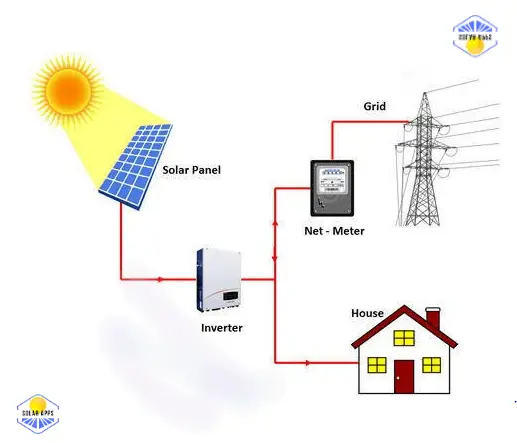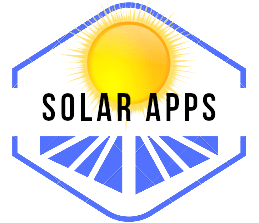An on-grid solar system, also known as a grid-tied or grid-connected solar system, is a solar power system that is connected to the electrical grid. Unlike off-grid solar systems that operate independently, on-grid systems are designed to work in conjunction with the local utility grid.

key features and components of an on-grid solar system:
- Solar Panels (Photovoltaic Modules): These are the devices that capture sunlight and convert it into electricity through the photovoltaic effect. Solar panels are typically mounted on the roof or ground to maximize sun exposure.
- Inverter: The
inverteris a crucial component of an on-grid solar system. It converts the direct current (DC) electricity generated by the solar panels into alternating current (AC), which is the type of electricity used in homes and the grid. - Mounting Structure: Solar panels need to be mounted securely in a way that optimizes their exposure to sunlight. The mounting structure can be roof-mounted, ground-mounted, or integrated into building structures.
- Grid Connection: The system is connected to the local utility grid. This connection allows for the flow of electricity between the solar system and the grid. When the solar system generates more electricity than is being used on-site, the excess electricity is fed back into the grid.
- Net Metering: On-grid systems often use a net metering arrangement with the utility company. Net metering allows homeowners or businesses to receive credit for the excess electricity they generate and feed back into the grid. During times when the solar system isn’t producing enough electricity (such as at night), power is drawn from the grid.
- Monitoring System: Many on-grid solar systems come with monitoring systems that allow users to track the performance of their solar panels in real-time. This monitoring can help users optimize their energy consumption and understand how much energy their system is producing.
- Grid Interaction: On-grid solar systems are designed to interact with the grid seamlessly. When your solar panels produce more electricity than your home or business is using, the excess energy is fed back into the grid. Conversely, when your electricity demand exceeds what the solar panels are producing (such as during the night), you draw power from the grid.
- Grid Stability and Voltage Regulation: On-grid solar systems can contribute to the stability of the electrical grid. In some cases, they may help regulate voltage levels on the grid. This is because the electricity generated by solar systems can be fed into the grid to meet local demand, reducing the need for utilities to rely solely on centralized power plants.
- Government Incentives: Many governments around the world offer incentives and subsidies to encourage the installation of solar power systems. These incentives may include tax credits, rebates, or feed-in tariffs, which pay system owners for the electricity they feed back into the grid.
- Integration with Other Technologies: Some on-grid solar systems are designed to work in conjunction with other technologies, such as energy storage systems (batteries). Adding a battery storage component to your on-grid system can allow you to store excess energy generated during the day for use during times when the sun is not shining, providing a degree of energy independence and backup power during grid outages.
- Sizing and Design Considerations: Proper sizing and design of an on-grid solar system are crucial to maximizing its efficiency and effectiveness. Factors such as the available roof or ground space, local climate conditions, and the electricity consumption patterns of the home or business must be taken into account during the design phase.
- Environmental Impact: By generating clean, renewable energy, on-grid solar systems contribute to a reduction in greenhouse gas emissions and dependence on non-renewable energy sources. This has positive environmental impacts by helping combat climate change and reducing air pollution.
- Maintenance: On-grid solar systems generally require minimal maintenance. Regular cleaning of the solar panels to remove dirt and debris, as well as occasional checks of the inverter and other components, are typically sufficient to keep the system running smoothly.
- Return on Investment: The return on investment for on-grid solar systems can be influenced by factors such as the cost of the system, available incentives, electricity prices, and the amount of sunlight the system receives. In many cases, the initial investment in a solar system can be recouped over time through energy savings and incentives.
Benefits of On-Grid Solar Systems:
- Cost Savings: By generating your own electricity, you can reduce your reliance on the grid, leading to potential cost savings on your electricity bills.
- Environmental Impact: On-grid solar systems help reduce greenhouse gas emissions by generating clean, renewable energy.
- Grid Support: During periods of high electricity demand, on-grid solar systems can contribute electricity to the grid, helping to stabilize and support the overall grid infrastructure.
It’s important to note that on-grid solar systems do not typically provide backup power during grid outages. If the grid goes down, on-grid systems are designed to shut down as a safety measure to prevent electricity from being sent back into the grid and endangering utility workers. To have backup power during outages, additional equipment such as battery storage systems can be added to the solar installation.
